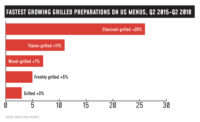Plant-Based Products Impact Menus
Foodservice operator strategies and product solutions aim to be on target

Last fall saw Sysco Corp. introduce nine new products, including Raised & Rooted (branded) Nuggets. Officials say the crispy, tempura-battered plant-protein nuggets deliver “meaty” texture and satisfying crunch that’s perfect for chicken nugget lovers looking for an alternative.
PHOTO COURTESY OF: SYSCO CORPORATION (WWW.SYSCO.COM)
The plant-based trend is here to stay. According to Mintel research on plant-based proteins, nearly two in five Americans are trying to add more plant-based foods into their diet, and more than half agree restaurants should offer more plant-based protein options.
So, what is the best way to appeal to this increasingly influential group? Here are five areas to keep in mind when targeting the plant-based consumer:
Appeal to flexitarians
Vegetarians and vegans represent a relatively small percentage of the US population. However, more than one in five Americans is a flexitarian, meaning they eat meatless meals some of the time. Flexitarians represent a larger opportunity, along with vegetarians and vegans. This collective consumer base follows a diet where they are cutting back on dairy and meat in some capacity. While flexitarians tend to be older women, vegans and vegetarians are more likely to be younger consumers who are adding more plant-based foods to their diets. Additionally, diners are more receptive to seeing meat alternatives on the menu, over strictly vegetarian or vegan menu item claims.
Promote health first
One of the biggest questions now is why are consumers eating plant-based foods? There are three main reasons: health, ethical and environmental. Health reasons, such as concerns about blood pressure or cholesterol, act as a main driver for consumers in general. Concerns about animal ethics or the impact of animal products on the environment are secondary drivers.
Emphasize taste
Despite health acting as a main driver for buying plant-based proteins, taste will always prevail. The novelty of a new plant-based menu item may drive initial trial, but if it’s not craveable, it will not lead to a repeat purchase. More than half of consumers choose a mix of healthy and indulgent options when dining out, creating a need for a spectrum of plant-based menu items, according to Mintel research on healthy dining trends. Plant-based comfort foods, like fried Buffalo cauliflower or Impossible cheeseburgers, have a place alongside health-focused dishes like loaded veggie grain bowls.
Balance health and the taste of meat
Consumers’ dietary preferences vary based on occasion and they’re starting to recognize that processed meat made from plants is not automatically healthier. More than three in five consumers agree whole plant foods are healthier than processed meat substitutes and one in seven agrees meat alternatives like Beyond Meat or the Impossible burger contain too many ingredients. However, diners, especially flexitarians, still crave the taste of meat. More than half of US consumers agree meat alternatives should closely mimic the taste of meat. Different occasions will call for different plant-based experiences meaning restaurants should offer processed meat substitutes as well as plant-forward dishes.
Add a proprietary spin
According to an upcoming Mintel report on dining out, more than one in five diners wants restaurants to offer more plant-based entrees in 2020. While operators across the country are adding more plant-based options, many of these options are the same processed meat substitutes. Offering proprietary plant-based menu items is one way to attract diners and help restaurants stand out from the competition.
Originally appeared in the January 2020 issue of Prepared Foods as "Flex" the Menu.
Looking for a reprint of this article?
From high-res PDFs to custom plaques, order your copy today!






